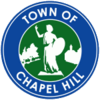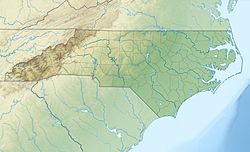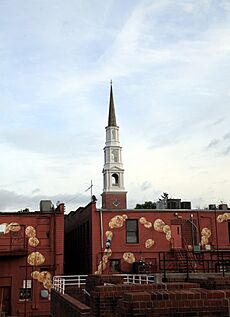Chapel Hill, North Carolina facts for kids
Quick facts for kids
Chapel Hill
|
|||
|---|---|---|---|
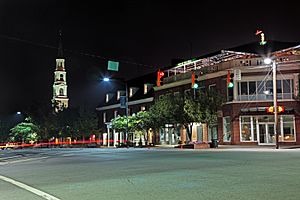
Franklin Street
|
|||
|
|||
| Nickname(s):
Southern Part of Heaven
|
|||
| Motto(s):
"Learning, Serving & Working Together To Build A Community Where People Thrive."
|
|||
| Country | United States | ||
| State | North Carolina | ||
| County | |||
| Founded | 1793 | ||
| Chartered | 1851 | ||
| Named for | New Hope Chapel | ||
| Government | |||
| • Type | Council–manager | ||
| Area | |||
| • Total | 21.75 sq mi (56.32 km2) | ||
| • Land | 21.60 sq mi (55.93 km2) | ||
| • Water | 0.15 sq mi (0.39 km2) 0.69% | ||
| Elevation | 262 ft (80 m) | ||
| Population
(2020)
|
|||
| • Total | 61,960 | ||
| • Estimate
(2023)
|
62,043 | ||
| • Density | 2,869.05/sq mi (1,107.75/km2) | ||
| Time zone | UTC-5 (EST) | ||
| • Summer (DST) | UTC-4 (EDT) | ||
| ZIP codes |
27514-27517
|
||
| Area codes | 919, 984 | ||
| FIPS code | 37-11800 | ||
| GNIS feature ID | 2406255 | ||
| Primary Airport | RDU | ||
Chapel Hill is a town in Orange and Durham County, North Carolina, United States. Its population was 61,960 in the 2020 census, making Chapel Hill the 17th-most populous municipality in the state. Chapel Hill and Durham make up the Durham-Chapel Hill, NC Metropolitan Statistical Area, which had an estimated population of 608,879 in 2023. When it's combined with Raleigh, the state capital, they make up the corners of the Research Triangle (officially the Raleigh-Durham-Cary, NC Combined Statistical Area), which had an estimated population of 2,368,947 in 2023.
The town was founded in 1793 and is centered on Franklin Street, covering 21.3 square miles (55 km2). It contains several districts and buildings listed on the National Register of Historic Places. The University of North Carolina at Chapel Hill and UNC Health Care are a major part of the economy and town influence. Local artists have created many murals in the town.
Contents
History
Pre-establishment and colonial era
The Occaneechi Indians lived in the area of what is now Hillsborough, north of Chapel Hill, prior to European settlement.
The area was the home place of early settler William Barbee of Middlesex County, Virginia, whose 1753 grant of 585 acres on the north and south side of "Lick Branch" from John Carteret, 2nd Earl Granville was the first of two land grants in what is now the Chapel Hill-Durham area. Though William Barbee died shortly after settling there in 1758, one of his eight children, Christopher Barbee, became an important contributor to his father's adopted community and to the fledgling University of North Carolina. In 1792, he offered the trustees of UNC 221 acres on which the university is now built, making him the university's largest donor.
Chapel Hill has developed along a hill; the crest was the original site of a small Anglican "chapel of ease", built in 1752, known as New Hope Chapel. The Carolina Inn now occupies this site. In 1819, the town was founded by the NC General Assembly to serve the University of North Carolina and developed around it. The town was chartered in 1851, and its main street, Franklin Street, was named in memory of Benjamin Franklin.
Civil War
Four in ten Chapel Hillians were enslaved at the start of the Civil War, and about half of the town was Black. In April 1865, as the war ended, the 9th Michigan Cavalry rode into Chapel Hill and occupied the university and the town for more than two weeks.
Civil rights era
In 1969, a year after the town fully integrated its schools, Chapel Hill elected Howard Lee as mayor. It was the first majority-white municipality in the South to elect an African-American mayor. Serving from 1969 to 1975, Lee helped establish Chapel Hill Transit, the town's bus system, and the Mountains-to-Sea trail.
Some 30 years later, in 2002, the state passed legislation to provide free service to all riders on local buses. The bus operations are funded through Chapel Hill and Carrboro town taxes, federal grants, and UNC student tuition. The change has resulted in a large increase in ridership, taking many cars off the roads. Several hybrid and articulated buses have been added recently. All buses carry GPS transmitters to report their location in real-time to a tracking web site. Buses can transport bicycles and have wheelchair lifts.
In 1993, the town celebrated its bicentennial and founded the Chapel Hill Museum. This cultural community resource "exhibiting the character and characters of Chapel Hill, North Carolina" includes among its permanent exhibits Alexander Julian, History of the Chapel Hill Fire Department, Chapel Hill's 1914 Fire Truck, The James Taylor Story, Farmer/James Pottery, and The Paul Green Legacy.
In addition to the Carolina Inn, the Beta Theta Pi Fraternity House, Chapel Hill Historic District, Chapel Hill Town Hall, Chapel of the Cross, Gimghoul Neighborhood Historic District, Alexander Hogan Plantation, Old Chapel Hill Cemetery, Old East, University of North Carolina, Playmakers Theatre, Rocky Ridge Farm Historic District, and West Chapel Hill Historic District are listed on the National Register of Historic Places.
Geography and climate
Chapel Hill is located in the southeast corner of Orange County, with a small part extending east into Durham County. It is bounded on the west by the town of Carrboro and on the northeast by the city of Durham. However, most of Chapel Hill's borders are adjacent to unincorporated portions of Orange and Durham Counties rather than shared with another municipality. According to the United States Census Bureau, the town has a total area of 21.75 square miles (56.3 km2), of which 21.60 square miles (55.9 km2) is land and 0.15 square miles (0.39 km2) (0.69%) is water.
| Climate data for Chapel Hill, NC (1991–2020 normals, extremes 1891–present) | |||||||||||||
|---|---|---|---|---|---|---|---|---|---|---|---|---|---|
| Month | Jan | Feb | Mar | Apr | May | Jun | Jul | Aug | Sep | Oct | Nov | Dec | Year |
| Record high °F (°C) | 85 (29) |
85 (29) |
92 (33) |
98 (37) |
98 (37) |
104 (40) |
107 (42) |
106 (41) |
104 (40) |
99 (37) |
88 (31) |
84 (29) |
107 (42) |
| Mean daily maximum °F (°C) | 50.7 (10.4) |
54.3 (12.4) |
61.8 (16.6) |
71.5 (21.9) |
78.6 (25.9) |
85.7 (29.8) |
89.5 (31.9) |
87.5 (30.8) |
81.8 (27.7) |
72.1 (22.3) |
62.0 (16.7) |
53.7 (12.1) |
70.8 (21.6) |
| Daily mean °F (°C) | 40.0 (4.4) |
42.8 (6.0) |
49.9 (9.9) |
59.2 (15.1) |
67.5 (19.7) |
75.4 (24.1) |
79.4 (26.3) |
77.6 (25.3) |
71.7 (22.1) |
60.3 (15.7) |
49.9 (9.9) |
43.1 (6.2) |
59.7 (15.4) |
| Mean daily minimum °F (°C) | 29.4 (−1.4) |
31.3 (−0.4) |
38.0 (3.3) |
46.8 (8.2) |
56.3 (13.5) |
65.0 (18.3) |
69.3 (20.7) |
67.7 (19.8) |
61.5 (16.4) |
48.5 (9.2) |
37.8 (3.2) |
32.4 (0.2) |
48.7 (9.3) |
| Record low °F (°C) | −8 (−22) |
−6 (−21) |
9 (−13) |
20 (−7) |
29 (−2) |
40 (4) |
48 (9) |
42 (6) |
35 (2) |
20 (−7) |
12 (−11) |
0 (−18) |
−8 (−22) |
| Average precipitation inches (mm) | 3.95 (100) |
3.27 (83) |
4.39 (112) |
3.71 (94) |
3.78 (96) |
4.08 (104) |
4.82 (122) |
4.30 (109) |
5.42 (138) |
3.77 (96) |
3.50 (89) |
3.87 (98) |
48.86 (1,241) |
| Average snowfall inches (cm) | 1.5 (3.8) |
0.9 (2.3) |
0.1 (0.25) |
0.0 (0.0) |
0.0 (0.0) |
0.0 (0.0) |
0.0 (0.0) |
0.0 (0.0) |
0.0 (0.0) |
0.0 (0.0) |
0.1 (0.25) |
0.2 (0.51) |
2.8 (7.1) |
| Average precipitation days (≥ 0.01 in) | 11.3 | 10.4 | 11.5 | 9.9 | 10.3 | 10.7 | 10.9 | 10.7 | 9.1 | 8.5 | 9.2 | 11.3 | 123.8 |
| Average snowy days (≥ 0.1 in) | 0.9 | 0.7 | 0.1 | 0.0 | 0.0 | 0.0 | 0.0 | 0.0 | 0.0 | 0.0 | 0.0 | 0.2 | 1.9 |
| Source: NOAA | |||||||||||||
Demographics
| Historical population | |||
|---|---|---|---|
| Census | Pop. | %± | |
| 1880 | 831 | — | |
| 1890 | 1,017 | 22.4% | |
| 1900 | 1,099 | 8.1% | |
| 1910 | 1,149 | 4.5% | |
| 1920 | 1,483 | 29.1% | |
| 1930 | 2,699 | 82.0% | |
| 1940 | 3,654 | 35.4% | |
| 1950 | 9,177 | 151.1% | |
| 1960 | 12,573 | 37.0% | |
| 1970 | 26,199 | 108.4% | |
| 1980 | 32,421 | 23.7% | |
| 1990 | 38,719 | 19.4% | |
| 2000 | 48,715 | 25.8% | |
| 2010 | 57,233 | 17.5% | |
| 2020 | 61,960 | 8.3% | |
| 2023 (est.) | 62,043 | 8.4% | |
| U.S. Decennial Census 2020 |
|||
2020 census
| Race | Number | Percentage |
|---|---|---|
| White (non-Hispanic) | 38,678 | 62.42% |
| Black or African American (non-Hispanic) | 5,848 | 9.44% |
| Native American | 151 | 0.24% |
| Asian | 9,275 | 14.97% |
| Pacific Islander | 19 | 0.03% |
| Other/Mixed | 3,255 | 5.25% |
| Hispanic or Latino | 4,734 | 7.64% |
As of the 2020 census, there were 61,960 people, 20,369 households, and 10,552 families residing in the town.
2010 census
At the 2010 census, there were 57,233 people in 20,564 households residing in the town. The population density was 2,687 people per square mile (1,037 people/km2). The racial composition of the town was 72.8% White, 9.7% African American, 0.3% Native American, 11.9% Asian, 0.02% Pacific Islander, 2.7% some other race, and 2.7% of two or more races. About 6.4% of the population was Hispanic or Latino of any race.
Of the 20,564 households, 51.1% were families, 26.2% of all households had children under the age of 18 living with them, 40.2% were headed by married couples living together, 8.2% had a female householder with no husband present, and 48.9% were not families. About 30.6% of all households were made up of individuals, and 7.7% had someone living alone who was 65 years of age or older. The average household size was 2.35 and the average family size was 2.98.
In the town, the population was distributed as 17.4% under the age of 18, 31.5% from 18 to 24, 23.6% from 25 to 44, 18.4% from 45 to 64, and 9.2% who were 65 years of age or older. The median age was 25.6 years. For every 100 females, there were 87.2 males. For every 100 females age 18 and over, there were 83.6 males.
According to estimates released by the U.S. Census Bureau, over the three-year period of 2005 through 2007, the median income for a household in the town was $51,690, and for a family was $91,049. Males had a median income of $50,258 versus $32,917 for females. The per capita income for the town was $35,796. About 8.6% of families and 19.8% of the population were below the poverty line, including 8.6% of those under age 18 and 5.6% of those age 65 or over.
Chapel Hill is North Carolina's best-educated municipality, proportionately, with 77% of adult residents (25 and older) holding an associate degree or higher, and 73% of adults possessing a baccalaureate degree or higher.
Education
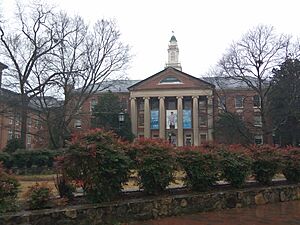
Chapel Hill-Carrboro City Schools covers most of the towns of Chapel Hill and Carrboro, along with portions of unincorporated Orange County, and is recognized for its academic strengths. East Chapel Hill High School, Carrboro High School, and Chapel Hill High School have all received national recognition for excellence, with Newsweek in 2008 ranking East Chapel Hill High as the 88th-best high school in the nation, and the highest-ranked standard public high school in North Carolina. The small portion of Chapel Hill located in Durham County is part of Durham Public Schools.
There are several private K-12 schools in Chapel Hill, including Emerson Waldorf School.
Founded in 1789, the University of North Carolina at Chapel Hill is a public research university and is the flagship of the University of North Carolina System.
The state's main youth orchestra, Piedmont Youth Orchestra, is based in Chapel Hill.
Also located in the town is the Chapel Hill Public Library, directed by Atlas Logan.
Culture
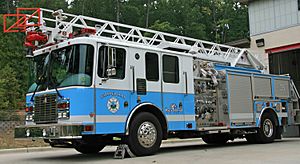
Though Chapel Hill is a principal town of a large metropolitan area, it retains a relatively small-town feel. Combined with its close neighbor, the Chapel Hill-Carrboro area has roughly 85,000 residents. Many large murals can be seen painted on the buildings. Most of these murals were painted by UNC alumnus Michael Brown. Also, for more than 30 years, Chapel Hill has sponsored the annual street fair, Festifall, in October. The fair offer booths to artists, craftsmakers, nonprofits, and food vendors. Performance space is also available for musicians, martial artists, and other groups. The fair is attended by tens of thousands each year.
The Morehead Planetarium and Science Center was the first planetarium built on a U.S. college campus. When it opened in 1949, it was one of six planetariums in the nation and has remained an important town landmark. During the Mercury, Gemini, and Apollo programs, astronauts were trained there. One of the town's hallmark features is the giant sundial, located in the green square in front of the planetarium on Franklin Street.
Influences of the university are seen throughout the town, even in the fire departments. Each fire station in Chapel Hill has a fire engine (numbers 31, 32, 33, 34, and 35) that is Carolina blue. These engines are also decorated with different UNC decals, including a firefighter Rameses.
Chapel Hill also has some new urbanist village communities, such as Meadowmont Village and Southern Village. Meadowmont and Southern Village both have shopping centers, green space where concerts, movies, and other outdoor events have taken place, community pools, and schools. Also, a traditional-style mall with a mix of national and local retailers is located at University Place.
Food
Hailed as one of America's Foodiest Small Towns by Bon Appétit, Chapel Hill is rapidly becoming a hot spot for pop American cuisine. Among the restaurants noted nationally are Mama Dip's (Food Network's $40 A Day With Rachael Ray), Crook's Corner, Sunrise Biscuit Kitchen (The Splendid Table), caffè Driade (Food Network's $40 A Day With Rachael Ray), Lantern Restaurant (Food & Wine, Southern Living, etc.), and Vimala's Curryblossom Cafe.
Music
In the realm of popular music, James Taylor, George Hamilton IV, Southern Culture on the Skids, Superchunk, Polvo, Archers of Loaf, Ben Folds Five, The Kingsbury Manx, Spider Bags and more recently Porter Robinson, are among the most notable musical artists and acts whose careers began in Chapel Hill. The town has also been a center for the modern revival of old-time music with such bands as the Ayr Mountaineers, Hollow Rock String band, Watchhouse (formerly known as Mandolin Orange), the Tug Creek Ramblers, Two Dollar Pistols, the Fuzzy Mountain String band, Big Fat Gap and the Red Clay Ramblers.
Chapel Hill was also the founding home of now Durham-based Merge Records. Bruce Springsteen has made a point to visit the town on four occasions. His most recent appearance was on September 15, 2003, at Kenan Memorial Stadium with the E Street Band. U2 also performed at Kenan on the first American date of their 1983 War Tour, where Bono climbed up to the top of the stage, during pouring rain and lightning, holding up a white flag for peace. The 2011 John Craigie song, "Chapel Hill", is about the singer's first visit there. One song from Dirty, a Sonic Youth album, is named after the town.
Sports
The University of North Carolina has been very successful at college basketball and women's soccer, and a passion for these sports has been a distinctive feature of the town's culture, fueled by the Tobacco Road rivalry among North Carolina's four ACC teams: the North Carolina Tar Heels, the Duke Blue Devils, the NC State Wolfpack, and the Wake Forest Demon Deacons.
The two largest sports venues in the town both house UNC teams. The Dean Smith Center is home to the men's basketball team, while Kenan Memorial Stadium is home to the football team. In addition, Chapel Hill is also home to Carmichael Arena which formerly housed the UNC men's basketball team, and currently is home to the women's team, and to the new Dorrance Field, home to men's and women's soccer and lacrosse teams.
Many walking/biking trails are in Chapel Hill. Some of these include Battle Branch Trail, Morgan Creek Trail and Bolin Creek Trail, Chapel Hill's oldest trail and most popular greenway.
Media
- WCHL: local AM radio station (1360AM, 97.9FM) providing talk radio, news, and local sports coverage as the flagship station of the Tar Heel Sports Network.
- WUNC: local public radio station (91.5FM) located on the UNC campus.
- WXYC: noncommercial student-run radio station (89.3FM) on the UNC campus. In 1994, it became the first radio station in the world to broadcast over the internet.
- The Daily Tar Heel is the nationally ranked, independent student newspaper that serves the university and the town. The free newspaper is printed thrice weekly during the academic year and weekly during summer sessions.
- The Sun Magazine is an independent, ad-free magazine that for more than 40 years has published personal essays, interviews, short stories, poetry, and photographs.
- Carrboro Citizen was a locally owned community newspaper covering local news, politics and town government of Chapel Hill and Carrboro. The last issue was published in October 2012.
- The metro area has TV broadcasting stations that serve the Raleigh-Durham Designated Market Area (DMA) as defined by Nielsen Media Research.
Transit
Bus
Chapel Hill has intracity bus service via Chapel Hill Transit. Go Triangle provides connection to the rest of the Triangle (Raleigh, Durham, and Hillsborough), of which the Hillsborough service is operated by Chapel Hill Transit, and supplemented mid-day by a county shuttle.
Light rail
The Durham–Orange Light Rail line, which would have run between Chapel Hill and Durham, entered planning and engineering phases in August 2017. The project was discontinued in April 2019.
Notable people

- Alice Adams, author
- Emil Amos, musician
- Owen Astrachan, Duke Professor of Computer Science
- George A. Baer (1903–1994), bookbinder
- Stephen Barrett, retired psychiatrist, webmaster of Quackwatch
- Lewis Black, stand-up comedian, author, actor
- Ash Bowie, musician
- Steve Breedlove, clergyman, bishop in the Anglican Church in North America
- Sean Bridgers, actor, screenwriter, director, producer
- Fred Brooks, computer scientist
- Christopher Browning, historian
- Cam Cameron, football coach
- Spencer Chamberlain, musician
- Doug Clark and the Hot Nuts, band.
- Fred C. Cole, librarian and historian
- Elizabeth Cotten, musician
- Floyd Council, blues singer, the "Floyd" after which Pink Floyd is named
- Butch Davis, former UNC football coach
- Hubert Davis, UNC basketball coach, ESPN analyst, former NBA basketball player
- Walter Royal Davis, North Carolina philanthropist and oil tycoon
- Anoop Desai, finalist on American Idol, singer
- Sarah Dessen, author
- David Drake, science fiction and fantasy novelist and small-press publisher
- Elizabeth Edwards, late wife of former U.S. Senator of North Carolina John Edwards
- John Edwards, former presidential candidate
- Lawrence Ferlinghetti, Beat Generation poet and co-founder of City Lights Book Sellers & Publishers. Earned a B.A. in journalism from UNC-Chapel Hill in 1941.
- Ben Folds, musician
- Paul Green, playwright
- John Grisham, author
- Meredith Hagner, actress, portrays Liberty Ciccone on As the World Turns
- Bernardo Harris, former NFL linebacker
- Dave Haywood, musician, member of the country music group Lady Antebellum
- Bunn Hearn, MLB pitcher
- Jack Hogan, actor, noted for his role as Private William Kirby on Combat! television series, 1962–1967
- Laurel Holloman, artist and actress. Known for The L Word television series.
- George Moses Horton, a slave poet, called "the black bard of Chapel Hill"
- Paul Jones, computer technologist
- Alexander Julian, fashion designer
- Michelle Kasold, Olympic field hockey player
- Charles Kuralt, journalist
- Kay Kyser, big band leader, entertainer
- Howard Lee, first black mayor of a predominantly white municipality in the South
- William Carter Love, U.S. Representative from North Carolina during the 1800s
- Mandolin Orange, Andrew Marlin and Emily Frantz, a folk/Americana duo
- Mac McCaughan, musician
- Nick McCrory, Olympic bronze medalist in diving
- Richard McKenna, novelist, The Sand Pebbles
- Mark Newhouse, professional poker player
- Mojo Nixon, singer
- Marty Ravellette, armless hero
- David Rees, political satirist, cartoonist of Get Your War On
- Porter Robinson, electronic music producer
- Brian Roberts, former MLB second baseman, two-time All-Star
- Dexter Romweber, rockabilly roots-rocker
- Aziz Sancar, winner of the 2015 Nobel Prize in Chemistry
- Betty Smith, novelist, A Tree Grows in Brooklyn
- Dean Smith, former basketball coach
- Oliver Smithies, physical biochemist and genericist, Nobel prizewinner
- Elizabeth Spencer, author of The Light in the Piazza
- Silda Wall Spitzer, wife of former New York governor Eliot Spitzer
- Chris Stamey, musician
- Brook Steppe, former NBA player
- Leo Sternbach, chemist and discoverer of benzodiazepines
- Matt Stevens, former NFL safety
- James Taylor, musician
- Paul B. Thompson (novelist), author and UNC alumnus
- Blair Tindall, author and musician
- Richard Trice, blues guitarist, singer and songwriter
- Willie Trice, blues guitarist, singer, songwriter and record producer. Elder brother of above
- Karl Edward Wagner, horror writer, editor, and small-press publisher
- Daniel Wallace, writer, author of Big Fish: A Novel of Mythic Proportions
- Manly Wade Wellman, novelist
- Roy Williams, men's basketball coach
- Thomas Wolfe, author. UNC alumnus. Chapel Hill appears as "Pulpit Hill" in his posthumous novel You Can't Go Home Again.
- Bayard Wootten (1875–1959), photographer and suffragette
Sister cities
 Puerto Baquerizo Moreno, San Cristóbal (Galápagos, Ecuador)
Puerto Baquerizo Moreno, San Cristóbal (Galápagos, Ecuador)
See also
 In Spanish: Chapel Hill (Carolina del Norte) para niños
In Spanish: Chapel Hill (Carolina del Norte) para niños



